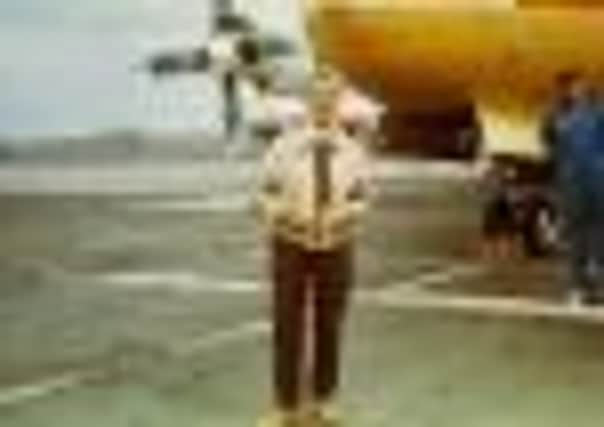Obituary: John Findlater, meteorologist


One of the UK’s leading meteorologists, who was twice decorated for his research and has a meteorological effect in the Indian Ocean named after him, has died in Inverness at the age of 86.
John Findlater was born in Motherwell but moved to the Highlands as a young boy when his father became locomotive superintendent to the Lochgorm engine shed at Inverness station.
Advertisement
Hide AdAdvertisement
Hide AdAnd while he grew up in a railway family in a railway town, it was to the skies that the young John Findlater turned his attention. Fascinated by aircraft, he joined the RAF during the Second World War and served on weather ships in the Atlantic. He spoke of seeing a Luftwaffe Focke Wulf Condor long-range patrol aircraft follow his vessel for days at a time.
He also told of the day the Captain sounded action stations because an aircraft was spotted on the horizon. As it drew closer, the crew could see that it wasn’t the Focke Wulf coming to blow them out of the water, but an RAF Coastal Command Liberator.
As the aircraft made a low pass beside the ship, the crew were intrigued to see a cameraman hanging out of the doorway, filming it as she ploughed through the swell. On his next shore leave John went to the cinema with a group of friends and was astounded to see his vessel on the Pathe newsreel and even recognised himself on deck staring up at the passing aircraft.
John was lucky to escape from a plane crash at the Longman airfield in Inverness during the war. He was a crewman in a Blenheim fighter bomber which was on a test flight over the Cairngorms after it had had repairs carried out on an engine.
An hour into the flight, the engine failed again and the pilot declared an emergency and turned for home. The crew knew they had one chance to land because, with only a single working engine, the pilot didn’t have enough power to abort, go around and try again. After struggling valiantly with the stricken aircraft, the pilot managed to crash land on the edge of the grass airstrip. John walked out of the wreckage. The rest of the crew were all critically injured and the Blenheim was written off.
After his demobilisation from the RAF at the end of the war, he joined the Meteorological Office where he remained until he retired as a Principal Scientific Officer in 1989.
Early in his career he was posted to Kenya, teaching meteorology to students in Nairobi. And it was here that his research began into the Monsoon winds which blow from the Horn of Africa towards India.
His work, which involved hundreds of flights out over the Indian Ocean to capture and measure data, resulted in his being awarded the LG Groves Memorial Prize for meteorology.
Advertisement
Hide AdAdvertisement
Hide AdThe Findlater Jet subsequently became a widely known meteorological phenomenon.
Upon his return to the UK, he pursued his hobby of gliding and became an accomplished pilot and instructor at the Lasham airfield in Hampshire. He would stay aloft for hours at a time riding thermals and upon seeing the Forth bridges in the distance on one trip, he realised he had better head for home.
His duties at the Met Office saw him work on air accident investigation and areas of meteorology relating to the military, which he never discussed. His last piece of investigative work saw him return to the Highlands for a special project just a few miles from his home.
He conducted an investigation into haar, sea mist which impacted military flying near the RAF bases at Kinloss and Lossiemouth. And it was for this research that in 1987 he was awarded a second LG Groves prize.
John had an encyclopaedic knowledge of military and civil aircraft, their design and propulsion systems. He was also an expert on airline policy and future aircraft design. He spoke knowledgeably and at length on aviation matters, whether military or civil, and was seldom happier than when he was flying in aircraft, looking at them or talking about them.
John Findlater had reservations about the scrapping of aircraft systems such as the Nimrod and Harrier and was an advocate of prolonging the airframe life of the now defunct Jaguar. He believed the Anglo-French fighter bomber was among the most capable warplanes ever built and frequently remarked on its capabilities in a number of combat roles.
His main passion was, of course, meteorology. Asking him about the weather usually resulted in a lengthy and complicated monologue, describing not only the current weather picture and the forecast for the coming week, but the meteorological phenomena behind each event.
Although a scientist through and through, he could tell you anything you wanted to know about the weather by a glance at the sky and a sniff of the air.
Advertisement
Hide AdAdvertisement
Hide AdA fellow of the Royal Meteorological Society, he spoke fondly of working with the Meteorological Research Flight at Farnborough and the hours he spent flying in a C-130 Hercules aircraft, specially adapted for meteorological analysis.
He was saddened when the aircraft’s distinguishing long red and white “barber’s pole” antennae, which protruded from the nose, was removed and the aircraft returned to normal use with an RAF squadron.
It was in this aircraft that he worked on the haar investigation and relished his station on the flightdeck behind the pilot, with a bank of meteorological instruments at his fingertips. He would wear a brown sheepskin flying jacket on these sorties and drove home from RAF Lossiemouth to Inverness after each flight, puffing gently on his pipe.
When he retired from the Met Office, he was awarded the Imperial Service Order for services to meteorology and returned to Inverness. He died suddenly but peacefully in Raigmore Hospital on 28 March.
He is survived by his wife Mary and daughter Fiona.
Mike Edwards